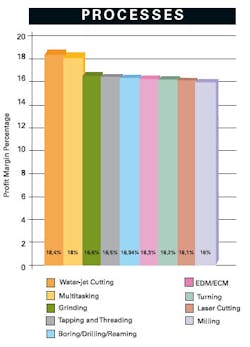Profit is critical to business — no profit, no business — and higher margins usually mean higher profit, so profit margins are a key indicator of performance and success. In the 2006 American Machinist Benchmarking Survey, net profit margin — defined as net profits divided by net revenues — was one of the factors used in identifying top performing machine shops.
The survey provides a wealth of information about the use of machining processes, techniques and tools, but it does not directly indicate how profitable each of those factors is. The survey does say how profitable companies that use those processes, techniques and tools are, and by averaging the profit margins of all the companies that use a particular process, technique or tool, we get a picture of how each factor contributes to profit. It is important to remember that that picture is somewhat ambiguous. If a company uses five of the factors covered in the survey, the company's profit margin could be attributed to all of them, even though several may be less profitable.
Instead of trying to determine exactly how profitable each process, technique or tool is, it is more useful to identify which of those factors are used by companies with higher margins. The following three tables indicate average profit margins of companies using each process, technique and tool identified in the survey.
